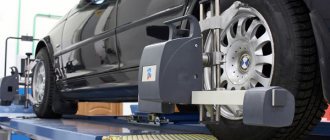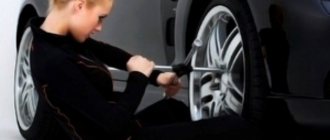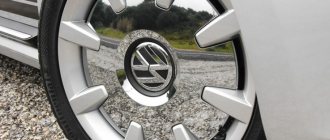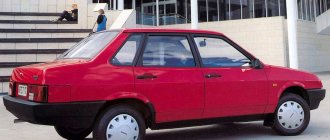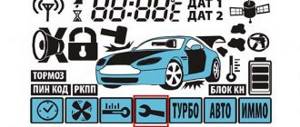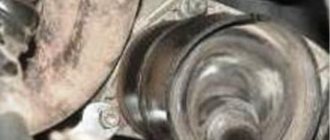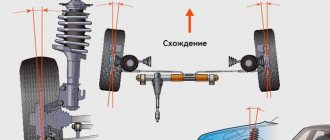What is wheel balancing and why is it needed?
Balancing means combining the geometric and actual centers of mass of the wheel. In simple terms, the geometric center of mass is the theoretical axis passing through the central hole. In practice, the actual center of mass almost never coincides with the central axis, but is located at some distance from it. The distance between these two points is called eccentricity. The discrepancy is due to the fact that the thickness of the tire in different areas can be different, in addition, the spool has additional weight, and the disk itself has slight differences in weight.
During rotation, moments of inertia arise that interfere with uniform circular motion, creating radial and axial runout. The magnitude of the moment of inertia depends on the unbalanced mass and the distance to the geometric axis. The only way to get rid of imbalance is to balance the free mass, aligning the axes of rotation and the center of mass.
Based on the above, we can safely say that the main task of wheel balancing is to eliminate radial and axial runout by compensating for mass by adding special weights or in some other way.
Consequences of wheel imbalance:
- Uneven wear of tires, due to which not only the handling deteriorates and the dynamic properties of the car decrease, but also the wear of the tires themselves significantly increases.
- Increased loads on parts and suspension units. As a rule, the first to fail are wheel bearings, which experience colossal radial loads due to wheel imbalance. A faulty bearing can jam at any time, which is especially dangerous at high speed. The steering ends will also not last long.
- Unpleasant noises and vibrations arise, which are transmitted to the steering wheel, as a result, controllability deteriorates and the level of comfort drops significantly. Driving a car with a vibrating steering wheel is a real punishment.
How often should you balance?
It should be noted that balancing must be carried out even when purchasing new disks, since there are often cases when a new product has a significant imbalance. Also, checking the absence of radial and axial runout should be carried out every 10-15 thousand kilometers. However, if during this period any emergency situations arose, for example, there was a collision with a curb or a wheel fell into a hole at speed, you must do an unscheduled check as soon as possible.
How often do you need wheel balancing?
Many drivers wonder how often should they balance their wheels? The balancing frequency depends on several factors and average indicators cannot be used.
There are separate recommendations from experts regarding the need for balancing:
- seasonal tire change;
- installation of new tires;
- using a new disk;
- buying a used car;
- suspension repair;
- the appearance of steering wheel beating;
- after 10-15 thousand kilometers;
- uneven tire wear;
- violation of the integrity or geometry of the disk;
There are 2 types of imbalance:
Static
When the car moves, the shifted center of gravity of the wheel distributes weight unevenly. When it rotates, a “pendulum effect” is observed.
If you manually spin the wheel on a lift, you can visually detect a displacement from the conventional center up and down. Another sign is short rotation.
Static imbalance is eliminated through the use of lead weights. The locations are indicated when checking on a balancing machine.
Dynamic
The movement of the wheel is characterized by complete separation of the axes of inertia and rotation. Weight is not distributed correctly across the width. Unbalance can be determined visually. When the wheel rotates, it moves 8 (figure eight).
Lead weights are used to eliminate imbalance. They are located on the inside and outside of the disc rim.
When both types of imbalance are eliminated, final balancing is performed. She is the control. If mistakes were made at the previous stages, she will identify them and correct them. It is highly accurate. Indicates the correct place to secure the load.
Signs that your wheels need to be balanced
- When driving at speed, noise appeared, this was especially noticeable at speeds above 100 km/h. The car began to drift away from its straight path.
- There were unpleasant vibrations on the steering wheel, which increased when accelerating.
- The tread depth varies in different areas, or uneven wear is noticeable on at least one of the wheels. Very often, due to imbalance on the front wheels, the edges of the tires are eaten away.
Before we consider the standard wheel balancing technology, let’s get acquainted with the types of imbalance.
Static imbalance
It occurs due to the fact that the center of gravity shifts some distance from the axis of rotation. That is, there is an uneven placement of weight around the circumference of the wheel, as a result of which the axes of rotation and inertia become parallel.
In order to check for static imbalance, just hang up the car wheel and spin it by hand. When the wheel stops spinning, its lowest point will be the heaviest place. For reliability, the experiment must be repeated several times; if the wheel stops in the same position, this indicates the presence of a static imbalance.
Dynamic imbalance
It is formed due to the mismatch of the axes of inertia and rotation. As a result, when the wheel rotates, significant radial runout is observed, since the mass is distributed unevenly across the entire width of the tire. To eliminate such phenomena, wheels are balanced using special equipment. Moreover, it should be noted that it is only possible to completely get rid of dynamic imbalance; coping with static imbalance is an impossible task for most auto repairmen.
Is balancing necessary?
Many people ask, why do balancing if the car behaves properly? And what happens if you don’t balance? Imagine that you are driving a car at a speed of 100 km/h and on a fourteen-inch rim you have an imbalance of approximately 20 grams. But the resulting load on the suspension is equivalent to blows from a three-kilogram hammer with a frequency of eight hundred times per minute. It's getting a little scary, isn't it?!
The result of such wear is the occurrence of tire slipping, and driving becomes unsafe. The imbalance leads to centrifugal forces appearing. With each meter of movement, the wheels randomly begin to change direction in different directions, and not at the same time. Just think what will happen to your car? Absolutely, control will be difficult, and the ending of such a trip may be sad.
As a result of the imbalance, tire wear will significantly increase, driving safety will decrease, suspension components will be destroyed, and the steering wheel will begin to vibrate. I think these reasons are quite enough to have your wheels balanced in a timely manner.
Of course, there may be car owners among you who will disagree and ask why balancing is needed, because they have been driving their car steadily for a long time and have not had any accidents. It’s just that you were very lucky that you didn’t get into a traffic accident, because a car is, first of all, a device that carries an increased danger, why increase it even more?
We recommend: How to check the functionality of a car thermostat?
Procedure technology
Equipment
It is important to prepare the wheels for the balancing procedure, namely, thoroughly clean the tread and disk from sand and dirt. If this rule is neglected, the operation may be performed inaccurately and will have to be repeated. If the car has already been balanced, the technician must remove the balancing weights before starting.
It is very important to check the tire pressure: the tires should not be flat. Before balancing the wheels, the center of gravity is determined, which is monitored by balancing machines. Devices can range from ordinary computers to huge systems with laser sensors and measurement mechanisms. Once determined, the machine automatically installs the balancing weight.
To carry out the procedure, a balancing machine is used, which aligns the position of the wheel along the center of the rotation axis during the procedure.
The type of balancing weight depends on the type of discs. Weights with fastening brackets are installed on steel disks, and with landing on the inside - on cast disks. They are mainly made from zinc, lead or steel.
Weight also depends on the level of imbalance. The weight of the balancing weight with bracket fasteners varies from 5 to 100 g. The weight of the weight for alloy wheels is from 5 to 60 g.
The complexity of the procedure also depends on the mass. The larger the weight, the more likely it is that the wheel needs to be checked for its external qualities: tread condition and general geometric qualities such as symmetry.
In the cold season, due to temperature fluctuations, adhesive weights may come off, which cannot happen with padded ones.
There are special types of weights for stamped wheels. They are stuffed between the disk and the tire, installed on the edge of the disk. Padded weights are not suitable for low-fusible discs. For this type, there are Velcro - self-adhesive weighting agents with an adhesive base. They are practically invisible, because they practically do not stand out from the general appearance. However, they are used only on a perfectly flat surface.
The process of balancing car wheels
The procedure for balancing a car starts with removing the discs, regardless of the characteristics of the model. Balancing occurs according to the following method: remove the wheel, balance it, put it back, then move on to the next one. This completes the procedure for all wheels.
The result depends mostly on the artist, and only a small part is due to the equipment. If the device is modern, then the specialist can only monitor the condition of the rubber and the progress of the procedure.
After cleaning the tread from stones and dirt, a plate is selected, depending on the number of holes in the disc. The specialist places the plate on the disk, tightening the nuts well. After that, he goes to the machine to balance the wheel.
Before balancing, remove any dirt or stones from the tire tread.
After identifying the problem area, the process of installing weights begins. Upon completion, the master returns to the equipment and re-checks the geometric condition of the wheel. If the procedure is successful, the wheel is installed in its place and the next one is taken. Otherwise, the procedure is repeated.
Errors during the procedure
It happens that specialists make mistakes by performing the procedure incorrectly. Let's look at the most common mistakes:
- Neglecting the procedure for cleaning the wheel from stones, sand and dirt. In this case, it will not be possible to achieve an imbalance value close to zero.
- Carrying out the procedure on a damaged wheel.
- Installing weights on top of old ones.
- Insufficient tightening of nuts and bolts on the wheel.
Closely monitor the work of specialists. Even the most experienced workers make mistakes. At the end of the procedure, make sure that the balancing was successful.
Safety precautions
The most basic safety rules during surgery include:
- Wheel balancing can only be carried out by a specialist who has reached the age of eighteen, has passed a medical examination and received permission to perform work of this complexity.
- Wheels weighing more than 20 kg are transported on trolleys or other devices.
- Before the procedure, the condition of the wheel is checked.
- The workplace should be clean, not cluttered with parts.
- Work is not carried out by specialists under the influence of alcohol or drugs.
You should trust your car only to qualified technicians.
How to check wheel balance
It is convenient to check wheel balancing when the season changes. Those who store seasonal tires usually change them themselves, so it will not be difficult for them to check the balancing themselves. It is important that the wheels are clean. For the procedure you will need regular chalk.
- Spin the wheel.
- Wait until the wheel stops completely and scratch with chalk anywhere. For example, in the middle of the tire.
- Repeat the first two points five to ten times.
- Check where the marks are located. If they are close to each other, then balancing is required.
- Otherwise, everything is fine with the wheel and you can save on the procedure.
Is it possible to balance only the front wheels?
When balancing only the front wheels, the steering wheel stops vibrating, so many drivers feel that there is no need to balance the rear wheels. This opinion is completely wrong.
The rear wheels, no less than the front ones, receive mechanical damage when driving over uneven surfaces, so they also need to be balanced
Despite the fact that driving when balancing only the front wheels becomes much more pleasant, the problem does not go away. Unfortunately, parts and suspension wear out not only in the rear of the car.
Is rear wheel balancing necessary?
You will probably ask, is it necessary to balance the rear wheels, since they are involved in driving the car? Of course, it is necessary, because the rear wheels are no less susceptible to mechanical stress than the front ones. And an imbalance will cause the same consequences.
Think about how the front wheels will behave during a trip if the rear wheels are hit by an impact opposite to the direction in which the car is moving? That's right, the front wheel will “slip” and the front suspension will suffer from such an impact. Now imagine that such impacts occur at least eight hundred times per minute? I suppose there is no point in explaining anything further.
We recommend: Instructions for reupholstering car seats with your own hands
Wheel balancing with granules
Today, the most effective way to get rid of imbalances is balancing with granules. The essence of the method is that instead of traditional weights, special granules are poured into the tire, which easily slide along the inner surface of the rubber. During rotation, rolling, they correct the process of mass distribution, thereby eliminating the imbalance of the wheel as a whole.
The advantages of this method are obvious, since the granules are poured once and, as a rule, are enough for the entire service life of the tire. Unlike the same weights, which very often fly off, granules are always inside and perform their tasks. The only reason why this technique has not yet received widespread recognition is the relatively high cost of the service.
To summarize, we once again draw the attention of car owners to the fact that wheel balancing is not a whim, but a mandatory procedure that must be carried out regularly to increase the service life of suspension elements and the tires themselves.
What is done to balance
The point of performing the balancing procedure is to check and correct the uniform distribution of the wheel mass relative to its axis of rotation. If an imbalance is detected, the mass distribution is adjusted by installing lead balancers (small flat weights) on the outer and inner sides of the disk. The exact locations of their installation on the wheel rim are calculated using special balancing equipment equipped with a sensitive system of touch sensors. Most modern stands allow for both static and dynamic balancing, and the weight of the balance weight is determined with an accuracy of tenths of a gram.
Modern cars can use different types of rims. Therefore, wheel balancing is carried out using two types of balancers. Thus, pressed weights are mainly placed on stamped steel disks. Most alloy wheels are fitted with adhesive balancing weights (“Velcro”). Such universal balancers are used in order not to spoil the original appearance of the discs - they are usually glued to the inside of the rim.
